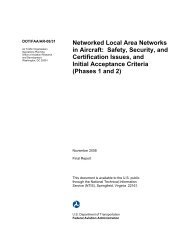Published Report (DOT/FAA/CT-94-36)
Published Report (DOT/FAA/CT-94-36)
Published Report (DOT/FAA/CT-94-36)
You also want an ePaper? Increase the reach of your titles
YUMPU automatically turns print PDFs into web optimized ePapers that Google loves.
4.7 TECHNICAL OBSERVER STATEMENT.<br />
The technical observers unanimously agreed that controllers<br />
appeared to separate aircraft with relative ease. In their<br />
report, the technical observers stated that during the<br />
simulation, the controllers had little difficulty detecting and<br />
resolving blunders. In some cases, controller response times<br />
were actually slower, as the controllers took time to evaluate<br />
the situation prior to issuing instructions to the evading<br />
aircraft. Alert algorithms and runway spacings appeared to be<br />
factors which allowed controllers to take extra time when<br />
evaluating certain situations.<br />
In conclusion, the technical observers unanimously agreed,<br />
ll...triple simultaneous approaches at the DIA airport can be<br />
safely accomplished using the 4.8 second update radar and the<br />
final monitor aid.<br />
4.8 RISK ASSESSMENT.<br />
The analyses above have assessed the controllers' ability to<br />
resolve blunders during simultaneous parallel ILS approaches. It<br />
was observed that the controllers were not always able to<br />
maintain the test criterion miss distance of more than 500 ft<br />
between the blundering aircraft and aircraft on adjacent<br />
approaches. To properly evaluate the proposed operations, the<br />
effect of implementing the proposed operation on the level of<br />
risk found in today's operational environment must be determined.<br />
Ideally, the probability of an accident during the approach<br />
operation could be computed and compared to an acceptable<br />
probability. However, since the majority of approach operations<br />
are conducted to single approaches, no recorded accident has ever<br />
been attributable to a blunder occurring during multiple approach<br />
operations. Accordingly, little effort has been made to record<br />
and track blunder occurrences.<br />
A way to complete the risk analysis without operational blunder<br />
data is to determine a target risk value, and then to compute a<br />
blunder rate which would result in the target risk value. This<br />
would provide insight to the safety level of the operation, and<br />
allow the <strong>FAA</strong> to assess the acceptability of the operation. The<br />
computed blunder rate should not be used as the sole determining<br />
factor of whether the operation meets the target risk value.<br />
The total number of air carrier accidents as well as the number<br />
of fatal accidents on final approach has been extracted from the<br />
National Transportation Safety Board (NTSB) data for the time<br />
period, 1983-1989. This number, together with the total number<br />
of ILS approaches during the time period, lead to an estimated<br />
fatal accident rate during ILS operations performed during IMC of<br />
4 x fatal accidents (ACC) per approach (APP). There are a<br />
40

















